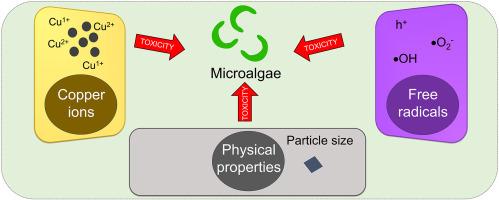多终点评价揭示钨酸铜(CuWO4)颗粒对亚capitata Raphidocelis微藻的毒性机制
IF 7.3
2区 环境科学与生态学
Q1 ENVIRONMENTAL SCIENCES
引用次数: 0
摘要
半导体在社会上有多种应用,包括光催化和电化学传感器。钨酸铜(CuWO4)颗粒可以降解水中的有机化合物,但在广泛使用前必须对其对水生生物群的有害影响进行评估。本研究旨在采用多参数方法评估CuWO4对标准微藻(Raphidocelis subcapitata)的毒性。我们的研究包括对生长、脂类、碳水化合物、叶绿素a、ROS产生、光合作用、细胞形态和理论计算的分析,以阐明该化合物的毒性机制。我们发现CuWO4在2.8 mg/L时对细胞生长有影响,随后在2.8和5.6 mg/L时细胞粒度和体积分别增加。我们还观察到细胞内ROS生成增加,光合作用受损,脂类(特别是甘油三酯- TAG,具有生物燃料的潜力),碳水化合物和叶绿素a含量的变化。除了铜离子释放引起的毒性作用和粒子的物理化学作用外,实验和理论化学分析表明,半导体CuWO4本身产生氧化物质,特别是光生成的h+(空穴)、羟基(OH)和超氧化物(O2-)自由基,这与暴露表面的欠配位程度和电子能级的局域化有关。我们的研究表明,虽然CuWO4在水体去污中是泛效的,但它对水生食物链底部的绿色微藻是有毒的,可能对这些生态系统构成威胁。我们强烈建议对其他水生生物进行进一步的生态毒理学研究,以更好地了解这种半导体对整个环境的影响。本文章由计算机程序翻译,如有差异,请以英文原文为准。

Unveiling the toxicity mechanism of copper tungstate (CuWO4) particles on the microalga Raphidocelis subcapitata assessed by multiple endpoints
Semiconductors have multiple applications in society, including photocatalysis and electrochemical sensors. Copper tungstate (CuWO4) particles can degrade organic compounds from water, but their deleterious effects on aquatic biota must be evaluated before their widespread use. We aimed to assess the toxicity of CuWO4 on the standardized microalga Raphidocelis subcapitata using a multiparameter approach. Our study comprehends the analysis of growth, lipid classes, carbohydrates, chlorophyll a, ROS production, photosynthesis, cell morphology, and theoretical calculations, to elucidate the toxicity mechanisms of this compound. We found that CuWO4 affected the growth at 2.8 mg/L, followed by an increase in cell granularity and volume at 2.8 and 5.6 mg/L, respectively. We also observed increased intracellular ROS production, photosynthesis impairment, and changes in lipid classes (especially triacylglycerol - TAG, with potential to biofuels), carbohydrates and chlorophyll a content. Besides the toxic effects caused by copper ion release and the physical and chemical effects of the particles, experimental and theoretical chemical analysis showed that the semiconductor CuWO4 itself produces oxidative species, especially photogenerated h+ (holes), and hydroxyl (⦁OH) and superoxide (⦁O2-) radicals, which can be associated with the localization of electronic levels summed to the undercoordination degree of the exposed surfaces. Our study shows that although CuWO4 is promisor in water decontamination, it is toxic to a green microalga at the base of aquatic food chains, being a possible threat to these ecosystems. Further ecotoxicological studies with other aquatic organisms is highly advised to better understand the effects of this semiconductor on entire environments.
求助全文
通过发布文献求助,成功后即可免费获取论文全文。
去求助
来源期刊

Environmental Pollution
环境科学-环境科学
CiteScore
16.00
自引率
6.70%
发文量
2082
审稿时长
2.9 months
期刊介绍:
Environmental Pollution is an international peer-reviewed journal that publishes high-quality research papers and review articles covering all aspects of environmental pollution and its impacts on ecosystems and human health.
Subject areas include, but are not limited to:
• Sources and occurrences of pollutants that are clearly defined and measured in environmental compartments, food and food-related items, and human bodies;
• Interlinks between contaminant exposure and biological, ecological, and human health effects, including those of climate change;
• Contaminants of emerging concerns (including but not limited to antibiotic resistant microorganisms or genes, microplastics/nanoplastics, electronic wastes, light, and noise) and/or their biological, ecological, or human health effects;
• Laboratory and field studies on the remediation/mitigation of environmental pollution via new techniques and with clear links to biological, ecological, or human health effects;
• Modeling of pollution processes, patterns, or trends that is of clear environmental and/or human health interest;
• New techniques that measure and examine environmental occurrences, transport, behavior, and effects of pollutants within the environment or the laboratory, provided that they can be clearly used to address problems within regional or global environmental compartments.
 求助内容:
求助内容: 应助结果提醒方式:
应助结果提醒方式:


